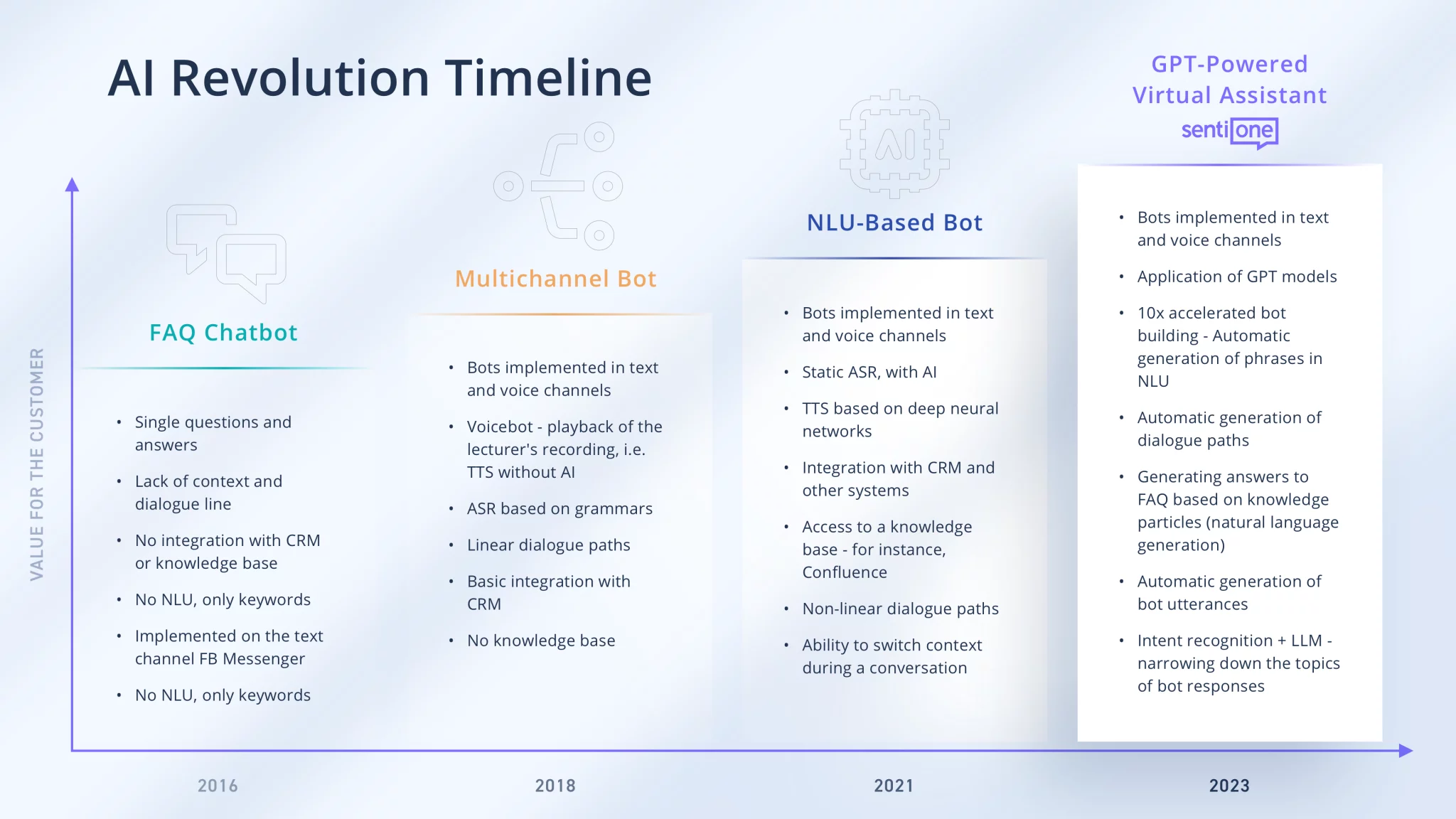The sudden popularity of ChatGPT — the GenAI chatbot that became the fastest-growing consumer application in history when it surpassed 100m monthly active users two months after launch — has got companies excited about automated conversational tools again.
But historically, chatbots received a poor reputation with customers — for their inaccuracies and lack of sophistication. A 2019 study by Forrester found that 54% of consumers in the US believed interacting with a chatbot would have a negative effect on their life.
Now AI is progressing — and so is the quality of chatbot interactions. We looked at the good, the bad and what’s next for the fast developing technology.
Where we’re at
Firstly, not all AI is GenAI. GenAI is the creation of content through a prompt, whereas conversational AI is the technology designed for human conversations and interactions, and for understanding human language, intents and needs. Chatbots can use both.
Andrew Fryckowski, head of bot design at SentiOne, a European company delivering conversational AI chatbots for enterprise businesses since 2011, says the technology underpinning conversational AI — natural language processing and natural language understanding — has developed dramatically over the past few years.

"Previously, chatbots were limited to point-and-click button bots that could only follow specific paths," says Fryckowski. "If you deviated from the scripted path, they would fail. These chatbots were designed for very specific and narrow use cases. However, with the integration of AI and natural language processing, we now have the ability to train chatbots to understand human speech and communication patterns."
But through the use of either voice or text — both as an input and as an output — conversational AI has become much more adaptable, and can now reach customers on a range of channels. For example, SentiOne says its bots score 96% in intent recognition accuracy, resembling a human level of understanding.
“Multimodal interactions, including images and videos, are now occurring across various channels like voice assistants and smart speakers,” says bot designer Marcella De Rosa. “This makes conversational AI accessible to a wider audience.”
Is ChatGPT the future of chatbots?
When it comes to GenAI, OpenAI, the builder of ChatGPT, recently released its API, allowing businesses including Expedia and Stripe to build chatbots using its technology.
However, it’s hard to control the answers that a ChatGPT bot may give — they may be beautifully worded, but could contain inaccuracies and a lack of logic. In other words, GenAI was not designed for conversations, but for generating answers based on existing data. However, conversational AI is designed to handle human-like conversations.
To encourage users to engage with bots instead of humans, bots must be highly useful, providing fast, efficient and human-like responses to queries
Bart Baziński, SentiOne’s chief executive, adds that using a black box technology (an AI where the user can’t see the inputs or operations) means businesses might not be in control of their customer’s data.
This raises questions about how customer data may be used to further train black box algorithms without their consent, which may result in sharing of highly confidential information.
"For prioritising greater control over your data privacy and the destination of your customer data, it is always recommended to opt for a provider that possesses their own technology and ensures secure hosting," says Fryckowski. "Our conversational AI platforms, especially those operating in the finance industry, offer the option for on-premise installations, allowing you to have a customised version of the platform hosted directly by your bank."
In combination with advances in natural language processing, Fryckowski says bots are increasingly trained to understand the slang of the markets they operate in. For example, this should create more "likeable" bots, which customers enjoy interacting with.
“To encourage users to engage with bots instead of humans, bots must be highly useful, providing fast, efficient and human-like responses to queries,” says De Rosa. “Conversational AI has proven effective in meeting all these requirements while being available 24/7 and extremely cost-effective. It is understandable that companies are relying more and more on it for their customer service strategies.”
How to train your chatbot
AI-powered chatbots require a large amount of data to fill out the large language models on which they run. SentiOne’s NLU engine is trained on large data sets from online monitoring. Each day their algorithms scan and analyse over 150m data points (customer posts, comments and opinions) sourced from the internet, and is then tailored to the needs of the clients using their conversations with customers.
Start by targeting some low-hanging fruit, maybe focusing on topics the platform already has training data on
“We typically begin by requesting a database of the original customer transcripts, which encompass real conversations with current customer service teams, whether through invoices or chat," says Fryckowski.
"A chatbot is always evolving. You always want to incorporate additional examples and address new topics. Launching a chatbot enables us to learn a great deal from the incoming messages, allowing us to analyse and categorise them effectively."
For startups that are early in their go-to-market strategy, and might not have reams of customer data to personalise their bots, you can still launch a chatbot to collate and understand customer interactions. Most platforms come preloaded with stock interactions for industries with high rates of automated customer services, for example in banking or e-commerce.
"Start by targeting some low-hanging fruit, maybe focusing on topics the platform already has training data on," says Fryckowski. "While it may not be completely accurate, that's okay because you can continue training it as you progress.
"By doing so at the beginning, you can readily harness a stream of data inputs. These inputs can be incorporated into the training data, speeding up the chatbot's learning process. However, if you opt to postpone the implementation, you will continue to get inputs, but you will need an extra step of manual training when you do embrace the technology."
What functionality does your business need?
For companies that are looking to automate their customer service offering, Baziński says finding a platform that can support an omnichannel approach is key.
“Startups should be thinking about how easy it is to connect the platform to their chosen communication channels,” says Baziński. “On some solutions that can take one or two clicks, for others it requires a lot of work.
“How easy is it to deploy to the channels your customers hang out on? If you are a fashion or beauty brand, you will likely need a solution that integrates with Instagram, for example.”
Startups should be thinking about how easy it is to connect the platform to their chosen communication channels
Baziński also recommends that startups and indeed any companies which are looking to automate their operations look for a platform that has detailed stats and analytics features that track progress over time.
“Bots are not a one-time project,” Baziński says. “You need to start it and monitor it and use solutions that provide you not only with capabilities in bot building, but also analytics, quality assurance, supervision and improvements.”



